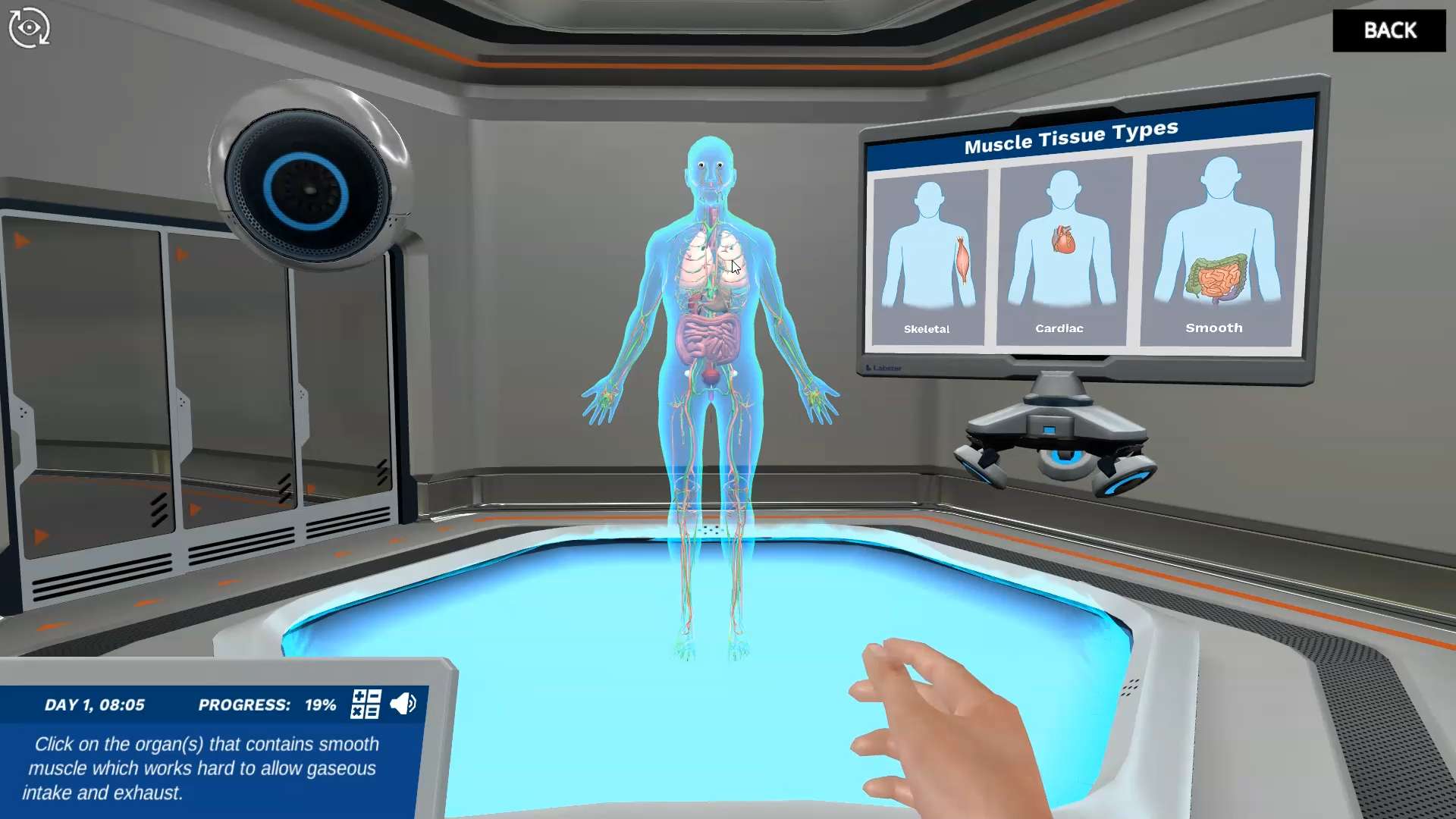Heading 1
Heading 2
Heading 3
Heading 4
Heading 5
Heading 6
Lorem ipsum dolor sit amet, consectetur adipiscing elit, sed do eiusmod tempor incididunt ut labore et dolore magna aliqua. Ut enim ad minim veniam, quis nostrud exercitation ullamco laboris nisi ut aliquip ex ea commodo consequat. Duis aute irure dolor in reprehenderit in voluptate velit esse cillum dolore eu fugiat nulla pariatur.
Block quote
Ordered list
- Item 1
- Item 2
- Item 3
Unordered list
- Item A
- Item B
- Item C
Bold text
Emphasis
Superscript
Subscript
About This Simulation
Explore the distribution and function of the three different muscle tissues found in the human body. Examine them down to the cellular level and dive further into their molecular structures to reveal the fascinating mechanisms behind muscle contractions.
Learning Objectives
- Broadly describe the major roles of muscle tissue
- Critically demonstrate how muscle contraction and relaxation is linked to thermoregulation, digestion, circulation and motor function
- Compare different types of muscle contraction
- Compare the contributions of different muscle types to body control and function
- Differentiate smooth, cardiac and skeletal muscle based on their microstructure and relate to organ functions
- Describe and identify the general organization and structural components of a skeletal muscle
- Define the sliding filament theory of skeletal muscle contraction
About This Simulation
Lab Techniques
Related Standards
- Alignment pending
- Alignment pending
- Alignment pending
Learn More About This Simulation
Did you know that you have more than 600 muscles in your body? Some of these muscles help to express your emotions through gesticulation and facial expressions, while the heart beats more than 3.3 billion times over 80 years! In this simulation, you will take a closer look at the three distinct muscle tissues we find in the human body and what purpose they serve.
Investigate the function of muscle tissues
Your first task is to learn about the different types of muscle tissues found in the human body. Interact with the anatomical 3D holograms to explore the distribution and main functions of skeletal, smooth, and cardiac muscle tissues. Using the control panel to navigate the different models, you will have to collect information about the tissues to solve different scenarios related to the muscular system.
Take a look inside the muscle cells
Continue your investigation by examining the muscle tissues at the cellular level to see how the individual muscle cells of each muscle tissue compare and contrast from one another. Pick up the cellular 3D models and examine the nuclei, myofibrils, mitochondria and more to understand how the intracellular components enable each muscle cell to perform the functions characteristic for that muscle tissue.
Observe how a muscle cell contracts
Follow the pathway that allows a nerve signal initiated in the brain to induce an actual muscle contraction in a skeletal muscle. Dive into the molecular level and see how the myofibrils are arranged in repeating units of sarcomeres. Compare a 3D model of a sarcomere to its electron micrograph and observe the changes that take place during contraction and relaxation. Finally, immerse yourself in the process of the sliding filament theory by interacting with the contractile proteins of a sarcomere.
Will you be able to figure out the molecular mechanisms that underlie muscle contraction?
For Science Programs Providing a Learning Advantage
Boost STEM Pass Rates
Boost Learning with Fun
75% of students show high engagement and improved grades with Labster
Discover Simulations That Match Your Syllabus
Easily bolster your learning objectives with relevant, interactive content
Place Students in the Shoes of Real Scientists
Practice a lab procedure or visualize theory through narrative-driven scenarios


FAQs
Find answers to frequently asked questions.
Heading 1
Heading 2
Heading 3
Heading 4
Heading 5
Heading 6
Lorem ipsum dolor sit amet, consectetur adipiscing elit, sed do eiusmod tempor incididunt ut labore et dolore magna aliqua. Ut enim ad minim veniam, quis nostrud exercitation ullamco laboris nisi ut aliquip ex ea commodo consequat. Duis aute irure dolor in reprehenderit in voluptate velit esse cillum dolore eu fugiat nulla pariatur.
Block quote
Ordered list
- Item 1
- Item 2
- Item 3
Unordered list
- Item A
- Item B
- Item C
Bold text
Emphasis
Superscript
Subscript
A Labster virtual lab is an interactive, multimedia assignment that students access right from their computers. Many Labster virtual labs prepare students for success in college by introducing foundational knowledge using multimedia visualizations that make it easier to understand complex concepts. Other Labster virtual labs prepare learners for careers in STEM labs by giving them realistic practice on lab techniques and procedures.
Labster’s virtual lab simulations are created by scientists and designed to maximize engagement and interactivity. Unlike watching a video or reading a textbook, Labster virtual labs are interactive. To make progress, students must think critically and solve a real-world problem. We believe that learning by doing makes STEM stick.
Yes, Labster is compatible with all major LMS (Learning Management Systems) including Blackboard, Canvas, D2L, Moodle, and many others. Students can access Labster like any other assignment. If your institution does not choose an LMS integration, students will log into Labster’s Course Manager once they have an account created. Your institution will decide which is the best access method.
Labster is available for purchase by instructors, faculty, and administrators at education institutions. Purchasing our starter package, Labster Explorer, can be done using a credit card if you are located in the USA, Canada, or Mexico. If you are outside of North America or are choosing a higher plan, please speak with a Labster sales representative. Compare plans.
Labster supports a wide range of STEM courses at the high school, college, and university level across fields in biology, chemistry, physics, and health sciences. You can identify topics for your courses by searching our Content Catalog.















